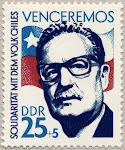In 1964 the CIA successfully subverted the election of Salvador Allende, the frontrunner during the election of that year, who unfortunately gave the United States Government “Red Scare” nightmares. Edwardo Frei instead assumed the presidency of Chile. But in 1970, Allende decided to run again: he was still a popular choice among the Chilean people, but the US still considered him a threat to the Chile’s freedom. The CIA would have to stop him again.

The agency contacted Henry Hecksher, the station chief in Santiago, and asked him for input on which of the candidates running against Allende (Frei could not run again) the US should support. Hecksher had an extensive CIA history, which included spying on the Soviets from Berlin, and his advice was trusted. So when he cast his vote in for a right-winger named Jorge Alessandri, Kissenger, back in Washington, gave the go ahead for the US to fund a political warfare campaign against the election of Allende.
The CIA began cycling vicious anti-Allende propaganda throughout Chile and the United States. The campaign was met with support from many, including the Vatican, and Time Magazine devoted their front cover to a scathing story about Allende. One of the few men who spoke out against the CIA’s involvement in Chile’s elections was Ambassador Korry, who called the agency’s tactics dreadful and hearkening back to Italy in 1948.
But on September 4, 1970, Allende was declared the winner of the three-way election with less than 37% of the vote, despite the storm of propaganda surrounding him. There was a small amount of time before Allende would officially assume office, and the CIA believed that they could still overturn the election results during that window.
The DCI Helm’s first idea was to stage a military coup, and he sent Hecksher to develop contacts with Chile’s military leaders. Although Hecksher had difficulty with this, he was close to Agostin Edwards, the owner of the largest copper mine in Chile, and a man of influence. Edwards would surely be able to help turn support against Allende. With Kissenger’s approval, the CIA endowed Edwards with large amounts of money to be used for more political warfare.
With that underway, Helms, still eager for a military coup, contacted Tom Polgar, the station chief in Buenos Aires, and instructed him to bring Alejandro Lanusse, a military Junta, to Washington. Once Lanusse arrived, Helms tried to persuade him to start a military coup against Allende, but the junta refused.
Now plans were diverging and two options were on the table, called Track 1 and Track 2. Track 1 was simply a flood of propaganda and political warfare. But Track 2, which Helms attempted to keep secret from Korry, revolved around military coup.
Trying to push Track 1 through, Helms contacted David Phillips, the station chief in Brazil, to ask for advice. Phillips did not believe Track 1 had much chance of success.
On September 27, the CIA approached General Paul Wimert and asked him to find Chilean officers who would support a military coup to overthrow Allende. Wimert gave them Roberto Viaux, a man who many considered insane.
Soon, though, Ambassador Korry found out about Helm’s deception and ordered he and Kissenger to back off. Naturally they disobeyed, and sent a cable to Santiago the next day ordering that a coup take place or at least an atmosphere conducive to one be created.
Hecksher began to have misgivings and attempted to dissuade an unresponsive Washington from overthrowing Allende. However, he conceded that, if the US wanted chaos in Chile, Viaux was the best option. And the plan for coup was on.
The CIA devised a plan in which General Schneider would be willfully kidnapped in Chile and taken to Argentina. The idea was that this would make Allende look weak, and congress would dissolve trying to clean up the mess, allowing Valenzuela, backed by the CIA, to take power with military force.
Despite all the trouble the CIA was having ousting Allende, it was projected that the odds of some kind of coup were growing, simply due to the fact that it had now become obvious that the CIA and the US wanted Allende out. It looked like the CIA’s kidnapping plan had a chance of success.
However, on October 22, just days before Allende was to assume office, Schneider was killed on his way to work by assassins working for Viaux. The CIA had no way to deal with this unexpected turn of events. They were at a loss. Two days later Allende’s victory was approved by the Chilean congress: 153 votes to 35.
The CIA’s intelligence failure was incredible. So much so, that President Nixon, beside himself with rage, spent much of the following few months attempting to cut the CIA’s budget. There was even talk of retooling the agency all together.
During the turmoil leading up to Allende’s election, he became more and more paranoid, going so far as to create a secret army for himself, “The Friends of the President.” And on September 11, 1973, a military coup took place, during which Allende killed himself with a pistol. Later that same day, dictator Augusto Pinochet took power. His regime ruled for 37 years and was responsible for the deaths of thousands of Chileans. When he took over, the CIA greeted him warmly.
-Tim Slover, December 10, 2008


No comments:
Post a Comment